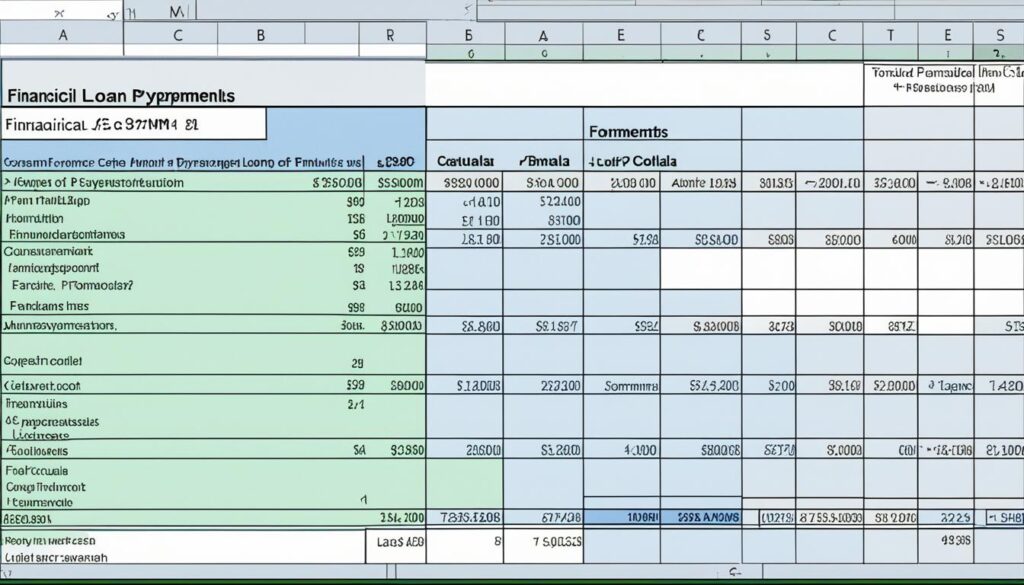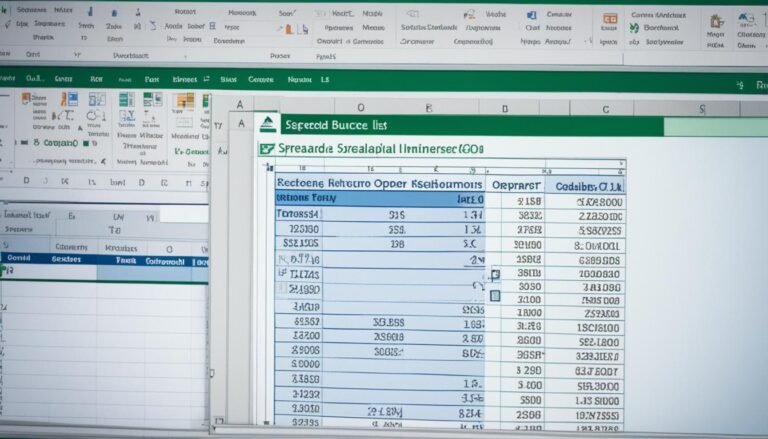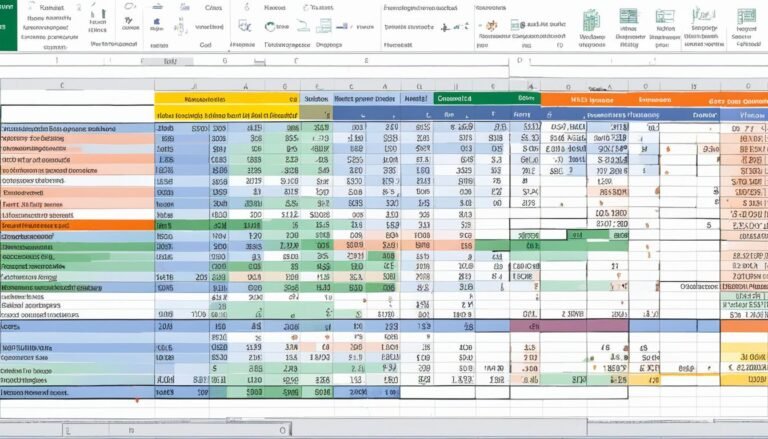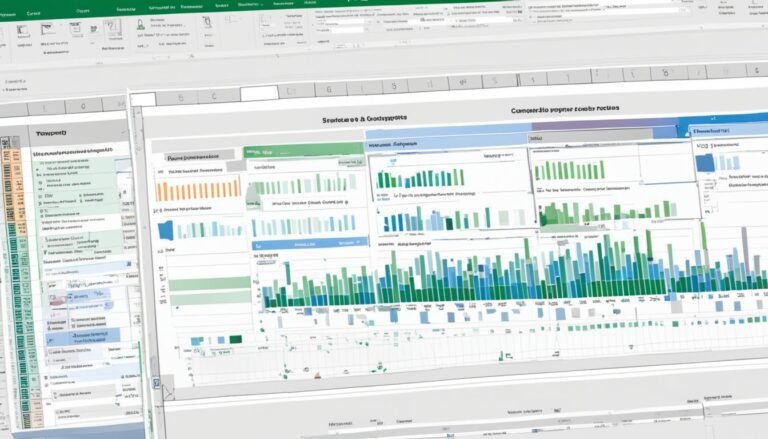Advanced Excel Formulas – Learn Powerful Tips and Tricks
With over 12 years of experience, I’ve taught advanced Excel formulas to many. I know they can transform how you work with data. These tools make calculations easier and unlock new ways to analyze data. You can do things like what-if analysis, conditional formatting, and data validation.
Excel offers more than just VLOOKUP. It has pivot tables, array formulas, and macros. In this guide, I’ll introduce key advanced Excel formulas for financial analysts. I’ll show you how to use them with real-life examples.
Key Takeaways
- Advanced Excel formulas empower users with powerful data analysis tools.
- Functions like INDEX MATCH offer a more robust alternative to VLOOKUP.
- Conditional logic with IF, AND, and OR simplifies complex calculations.
- OFFSET enables dynamic range calculations for variable data sets.
- SUMIF and COUNTIF allow conditional summing and counting based on criteria.
- Formulas like XNPV and XIRR are essential for irregular cash flow analysis.
Introduction to Advanced Excel Formulas
With over 12 years of Excel experience, I know the value of advanced Excel formulas. These powerful tools make complex calculations easy, analyze big datasets, and provide deep data insights.
Why Learn Advanced Excel Formulas?
Learning advanced Excel formulas saves time and increases accuracy. They let you do streamline calculations and better data analysis. This lifts your Excel skills to a whole new level.
Overview of the Most Useful Formulas
In the following parts, we’ll dive into key advanced Excel formulas. This includes INDEX MATCH, nested IF statements, OFFSET with SUM or AVERAGE, plus others. These formulas boost your workflow and open up advanced productivity and data analysis.
INDEX MATCH Formula
With over 12 years teaching Microsoft Excel, I’m excited to share that the INDEX MATCH formula has huge benefits. It’s perfect for those working with financial analysis or financial modeling. This mix is more flexible than the usual lookup formulas.
Understanding INDEX and MATCH Functions
INDEX MATCH uses INDEX and MATCH to operate. INDEX pulls a value from a table by its position. MATCH helps by finding where a specific value is in a row or column.
Examples of Using INDEX MATCH
The INDEX MATCH formula is awesome because it adapts automatically to new data. This is super helpful for ongoing financial modeling work.
Let’s say you’re working on a complex financial model with lots of data. INDEX MATCH links these data bits, ensuring your numbers are always right and updated, without you having to do it manually.
It’s great for handling not-so-simple lookup formulas too. Imagine this:
| Employee | Department | Salary |
|---|---|---|
| John Doe | Sales | $60,000 |
| Jane Smith | Marketing | $75,000 |
| Michael Johnson | Finance | $85,000 |
With INDEX MATCH, getting the salary of a certain employee in a specific department is easy. It works even if the data isn’t neatly organized.
For financial analysts and modelers, knowing INDEX MATCH means you can do a lot more with your data. It helps with more in-depth analyses, cuts down on repetitive tasks, and brings about new insights from your information.
IF Combined with AND/OR
After 12 years as an expert in Excel, I’ve learned a lot. Using IF with AND or OR makes formulas easier. It simplifies conditional logic by letting you check multiple things at once. You avoid long, hard-to-read formulas.
Nesting IF Statements
Before, people used nested IF for multiple checks in a formula. But it gets hard to manage and understand, especially with lots of checks. This method can also lead to mistakes. This makes fixing and understanding formulas in the future tough.
Using AND/OR with IF
Combine IF with AND or OR for clearer, shorter formulas. This helps anyone reading your work understand it better. It’s also great for data analysis because it handles complex situations well.
| Condition 1 | Condition 2 | Condition 3 | Result (IF with AND) | Result (IF with OR) |
|---|---|---|---|---|
| TRUE | TRUE | TRUE | TRUE | TRUE |
| TRUE | TRUE | FALSE | FALSE | TRUE |
| TRUE | FALSE | TRUE | FALSE | TRUE |
| FALSE | TRUE | TRUE | FALSE | TRUE |
| FALSE | FALSE | FALSE | FALSE | FALSE |
Using IF with AND returns TRUE only if all checks are TRUE. IF with OR returns TRUE with just one TRUE check. Mixing these helps you write clearer, shorter formulas. It makes dealing with conditional logic and data analysis easier.
OFFSET Combined with SUM or AVERAGE
For more than 12 years, I’ve shown how to use Excel to people and businesses. The OFFSET function is key. It lets you look at a changing set of cells when you use SUM or AVERAGE. It’s great for numbers with different rows or column counts.
Understanding the OFFSET Function
The OFFSET function picks a range of cells from a starting point. It uses how many rows and columns to move from that start. This kind of reference is perfect with SUM or AVERAGE for detailed calculations.
Dynamic Range Calculations with OFFSET
OFFSET + SUM or AVERAGE means your formulas can change their range on their own. If your data keeps growing in rows, your formula can keep up by itself.
It’s key for data that keeps getting bigger or changing. Instead of always updating by hand, letting OFFSET handle it saves time and boosts accuracy.
One of the key benefits of using OFFSET is that it allows you to create dynamic ranges that automatically update as your data changes, eliminating the need for manual adjustments and reducing the risk of errors.
No matter the data task, OFFSET with SUM or AVERAGE will be your go-to in Excel. It’s perfect for sales, different products, and more.
CHOOSE Function
Being an Excel expert for over 12 years, the CHOOSE function has been my go-to. It’s amazing for scenario analysis and decision-making in financial modeling. I can pick from different choices easily, making data analysis simpler.
For instance, let’s look at projecting a company’s revenue growth. Using the CHOOSE function, I can test different growth scenarios. Such as predicting low, medium, or high growth. This makes it easy to see how each case affects our revenue, with no need to update every value one by one.
The CHOOSE function works great with Excel’s data validation and drop-downs too. I can make interfaces where people can pick scenarios from a list. This lets coworkers or clients effortlessly see how different plans might play out.
The CHOOSE function changes the game for financial modeling and decision-making. Making it fast and easy to check different outcomes or options, smoothing the what-if analysis process.
Here’s an easy example of the CHOOSE function in action:
| Growth Scenario | Year 1 | Year 2 | Year 3 |
|---|---|---|---|
| Conservative | 5% | 6% | 7% |
| Moderate | 8% | 10% | 12% |
| Aggressive | 12% | 15% | 18% |
Let’s take the high growth scenario as an example. The formula would look like this:
=CHOOSE(3, 5%, 6%, 7%, 8%, 10%, 12%, 12%, 15%, 18%)
This formula picks the third choice, 12%, which stands for aggressive growth in Year 1.
XNPV and XIRR Formulas
With over 12 years of experience, I find the xnpv formula and xirr formula crucial for discounted cash flow analysis. These tools are vital for those in investment banking, equity research, and more. They ensure precise time value of money calculations.
Discounting Cash Flows with Uneven Periods
XNPV and XIRR differ from NPV and IRR because they handle inequal time periods between cash flows. They let you input actual dates for each cash flow. This is key in real-life cases where cash flows are not regular.
XNPV vs. NPV and XIRR vs. IRR
XNPV and XIRR offer a more flexible way for discounted cash flow calculations. Unlike NPV and IRR, which need equal time periods, XNPV and XIRR work with irregular periods. This makes them more suited for everyday investment situations.
| Function | Description | Use Case |
|---|---|---|
| XNPV | Calculates the net present value of an investment with irregular cash flows using a set discount rate. | Great for projects, acquisitions, and other investments with not regular cash flow patterns. |
| XIRR | Finds the internal rate of return for cash flows that are not regular. | Perfect for checking the profit of investments like real estate or venture capital with uneven cash flows. |
Using XNPV and XIRR in Excel improves the accuracy of your discounted cash flow work. They work well in complex situations with not standard cash flow periods.
SUMIF and COUNTIF
I’ve been teaching MS Excel for over 12 years. The SUMIF and COUNTIF formulas are like magic. They help enormously with data filtering and figuring out numbers based on certain conditions quickly.
Conditional Summing with SUMIF
SUMIF changes the game for conditional summing. You can add up only the cells you want. This is great for checking sales by product or revenue by region. It speeds up how you see and understand your business’s numbers.
Conditional Counting with COUNTIF
Then there’s COUNTIF. It counts cells that fit your rules. It’s perfect for checking on how employees are doing, keeping an eye on stock, or finding special cases in your data. COUNTIF helps you see how often certain things happen. This way, you can use the numbers to guide your choices.
SUMIF and COUNTIF work well as a pair. They let you look at your data very precisely. So, whether you’re handling sales, employee info, or anything else, these tools will be key in understanding your information. They’ll help you make smarter decisions based on what the data tells you.
PMT and IPMT Formulas
After teaching Excel for more than 12 years, I’ve seen how crucial the PMT and IPMT formulas are. They are key for financial experts working on loan calculations and more. I’ve shared these formulas with both individuals and big companies.
Calculating Loan Payments with PMT
The PMT formula helps find the regular loan payment amount. It considers the interest rate, number of payments, and initial loan amount. It’s extremely useful for figuring out payments on things like houses, cars, or other loans.
Separating Interest and Principal with IPMT
The IPMT formula is great because it separates the interest payment from the principal payment. This is needed to make amortization schedules and figure out how much of your payment goes to interest. With IPMT, you get a clear view of how your loan works. Plus, it helps with detailed financial analysis.

These tools are a must for jobs in banking, real estate, and financial analysis. If you know PMT and IPMT, you’re ready for complex financial questions. This includes roles focusing on loan analysis or reporting.
Advanced Excel Functions
With over 12 years of experience, I’ve seen how mastering advanced Excel functions boosts your data analysis. It makes your work easier and more efficient. The LEN and TRIM functions are key here.
LEN and TRIM Functions
The LEN function counts the characters in a text. This is great for checking data formats or character counts. You might use it to make sure product codes are the right length.
Data Cleaning with LEN and TRIM
Next, the TRIM function gets rid of unnecessary spaces. It’s ideal for cleaning up text data. This tool helps make your data consistent for the best analysis results.
Used together, LEN and TRIM provide a strong data cleaning solution. This gets your data ready for accurate analysis. By using these Excel functions, you improve your work efficiency and make better decisions based on solid data.
| Function | Description | Example |
|---|---|---|
| LEN | Returns the number of characters in a text string | =LEN(“Excel”) |
| TRIM | Removes leading and trailing spaces from a text string | =TRIM(” Hello World “) |
CONCATENATE Formula
I’ve been teaching Excel for 12 years now. The CONCATENATE formula is a key data formatting tool. It combines text from different cells into a single string. This is great for creating dynamic headers or labels in financial modeling.
Joining Text from Multiple Cells
Need to join text from different cells? The CONCATENATE function does it well. It smoothly merges names, addresses, or product details. This saves you time by doing the combining work for you.
Dynamic Headers and Labels
Concatenation’s top use is for making dynamic headers and labels for your worksheets. In financial modeling, reports need info from various sources. CONCATENATE helps build these headers accurately and keep them updated.
Imagine making a header like “Product X – North America Sales.” With CONCATENATE, it stays updated as data changes. This makes your data formatting smoother and your work look more professional.
| Product Name | Region | Dynamic Header |
|---|---|---|
| Widget A | Europe | =CONCATENATE(A2, ” – “, B2, ” Sales”) |
| Gadget B | Asia Pacific | =CONCATENATE(A3, ” – “, B3, ” Sales”) |
Using CONCATENATE well enhances your reports and financial modeling. You’ll manage data better and present your work more effectively.
CELL, LEFT, MID, and RIGHT Functions
With over 12 years in Excel, I’ve seen how valuable the CELL, LEFT, MID, and RIGHT functions are. They boost your data skills by helping with text tasks.
Extracting Text from Cells
The CELL function digs up data on a cell’s info, like its name or location. This is great for pulling out specific text pieces. The LEFT function grabs characters from the start of a text. The MID function reaches into a text and pulls out parts based on where you tell it to start and how long. And the RIGHT function does the same but from the end of the text.
Advanced Text Manipulation Techniques
Using these together lets you do amazing things with text. You can pull out, change, and analyze text info precisely. For example, use LEFT to find a product code in a big string. Then, MID can get a certain part of the string. And RIGHT can pinpoint the last few digits of an ID.
These skills are golden for big data sets or tricky data layouts. They let you sort and tweak data for better analysis or reports. Mastering these functions boosts how well you handle text data, making your work smoother and more pro.
Conclusion
As an Excel expert with over 12 years of experience, I’ve taught many people how to use the software. I believe that learning advanced Excel formulas is crucial for anyone in jobs involving data analysis, making financial models, or solving math problems.
Include these powerful functions in your Excel skills. You’ll make your work easier, do hard calculations faster, and understand your data more.
If you work as a financial analyst, investment banker, or in any job, being good at Excel is key. It will not just help you work better but also help you grow in your career. In today’s world, where everything is about data, it’s even more important.
We’ve looked at formulas like INDEX MATCH, OFFSET, and more. These are the tools that can help you stand out in your job. They make working with data quicker and smarter.
Keep learning more about advanced Excel formulas to stay ahead. It will make your data analysis more efficient and raise your productivity. Getting better at Excel is a smart move for your career. It opens up new chances and helps you make better choices based on data.
FAQ
Why should I learn advanced Excel formulas?
Learning advanced Excel formulas helps you do more with your data. It lets you automate calculations. You can also dig deeper into your data’s insights. This saves time and makes your analyses more accurate.
What is the INDEX MATCH formula, and when should I use it?
The INDEX MATCH formula is a powerful lookup tool. It beats VLOOKUP and HLOOKUP’s limits. It’s great for financial tasks, like finding data that changes often. This way, your models stay up to date.
How can I simplify complex conditional logic in my Excel formulas?
Make your Excel formulas simpler by using IF with AND or OR. This is much neater than long IF chains. It checks multiple conditions at once. Other users will find your formulas easier to follow.
How can I perform calculations over a variable range of cells in Excel?
Use the OFFSET function for dynamic references in Excel. It partners well with functions like SUM or AVERAGE. This helps when your data’s size changes, so your calculations stay accurate.
How can I perform scenario analysis and decision-making in financial modeling?
For decision-making, try the CHOOSE function in Excel. It works well for comparing different scenarios. You can see how choices affect your results easily.
What are XNPV and XIRR formulas, and when should I use them?
XNPV and XIRR are key for complex financial models with irregular cash flows. They’re better than NPV and IRR. They consider the exact dates of cash flows, making your analyses more precise.
How can I perform conditional calculations and data filtering in Excel?
SUMIF and COUNTIF make filtering data a breeze. They let you calculate or count cells based on conditions. These are essential for working with big data sets efficiently.
What are the PMT and IPMT formulas used for?
For finance tasks, PMT and IPMT are crucial. PMT figures out regular loan payments. IPMT separates interest from the principal. Together, they help with detailed financing calculations and schedules.
How can I clean and manipulate text data in Excel?
Excel’s LEN and TRIM functions are great for tidying up text. LEN counts characters in a string, while TRIM removes extra spaces. This makes your text data clean and uniform.
How can I join text from multiple cells into a single string?
Need to combine text in Excel? CONCACTENATE does it. It’s handy in financial models. You might use it for creating complex headers, for example.
What are the CELL, LEFT, MID, and RIGHT functions used for?
These functions are great for pulling data from texts. CELL tells you about a cell. LEFT, MID, and RIGHT let you grab parts of text strings. They’re useful for various text tasks in Excel.






